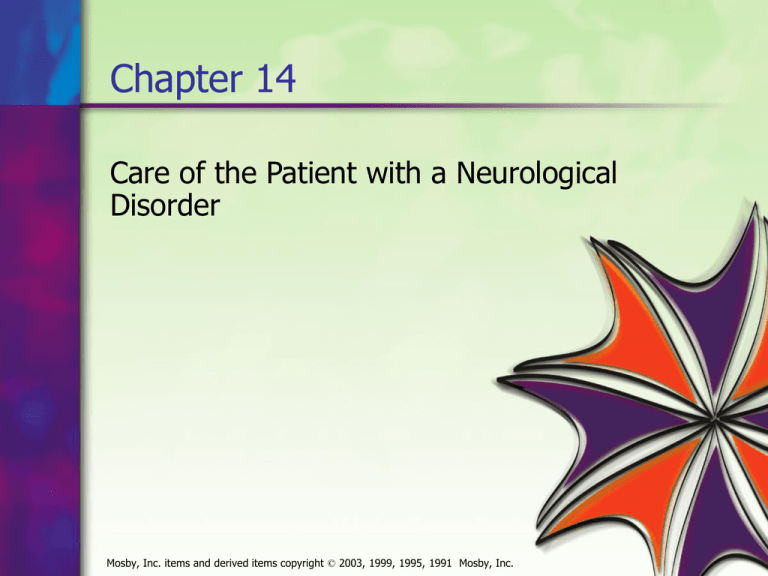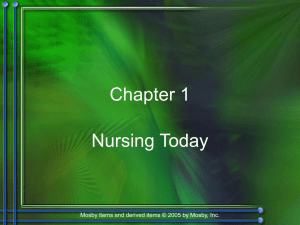Few4y efewfwfny
advertisement

Chapter 14 Care of the Patient with a Neurological Disorder Mosby, Inc. items and derived items copyright © 2003, 1999, 1995, 1991 Mosby, Inc. Care of the Patient with a Neurological Disorder The nervous system is responsible for communication and control within the body It is the body’s link with the environment and allows the interpretation of information and appropriate action to occur Two main structural divisions – central – peripheral Mosby, Inc. items and derived items copyright © 2003, 1999, 1995, 1991 Mosby, Inc. Neural Pathway Involved in the Patellar Reflex (Figure 14-3) Mosby, Inc. items and derived items copyright © 2003, 1999, 1995, 1991 Mosby, Inc. Effects of Aging on the Nervous System Loss of brain weight and loss of neurons Often an altered sleep/wakefulness ratio Decrease ability to regulate body temperature Decrease in the velocity of nerve impulses Blood supply to the spinal cord is decreased, resulting in decreased reflexes Normal changes are not the same as senility, organic brain disease, or Alzheimer’s disease Mosby, Inc. items and derived items copyright © 2003, 1999, 1995, 1991 Mosby, Inc. Prevention of Neurological Problems Some neurological problems can be prevented by modifying lifestyle factors, similar to risk factors for cardiovascular disorders: – Avoidance of drug and alcohol use – Safe use of motor vehicles – Safe swimming practices – no diving in shallow water – Safe handling and storage of firearms – Use of hardhats in dangerous construction areas – Use of protective padding as needed for sports Mosby, Inc. items and derived items copyright © 2003, 1999, 1995, 1991 Mosby, Inc. Laboratory and Diagnostic Examinations Assessment of the neurologically impaired patient includes a variety of lab and diagnostic exams Variety of blood tests ABGs Cerebrospinal fluid Brain scan MRI Lumbar puncture Positron emission tomography (PET) Angiogram Electromyogram (EMG) CT scan Electroencephalog ram (EEG) Myelogram Mosby, Inc. items and derived items copyright © 2003, 1999, 1995, 1991 Mosby, Inc. Increased Intracranial Pressure Increase in the volume of one of the contents of the cranium (blood, brain, blood vessels, or cerebrospinal) results in increased intracranial pressure (ICP) because the cranial vault is rigid and will not expand Classic signs – Restlessness – Disorientation – Headache – Contralateral hemiparesis – Visual changes including blurring and diplopia Mosby, Inc. items and derived items copyright © 2003, 1999, 1995, 1991 Mosby, Inc. Nursing Intervention for ICP Elevate the head of the bed to 30-45 degrees to promote venous return Place the neck in a neutral position to promote venous drainage Position the patient to avoid flexion of the hips, waist and neck Instruct the patient to avoid isometric or resistive exercises and Valsalva’s maneuver Have a Foley catheter in place Perform suctioning only as necessary Administer oxygen and use a hypothermia blanket as necessary Mosby, Inc. items and derived items copyright © 2003, 1999, 1995, 1991 Mosby, Inc. Neurological Disorders Epilepsy – caused by sudden, excessive and disorderly electrical discharges of the brain Stroke – most common disease – caused by thrombus, embolus, or hemorrhage Degenerative diseases: – Multiple sclerosis – unknown cause – Parkinson’s disease – damage or loss of dopamine-producing cells – Alzheimer’s disease – unknown cause – Myasthenia gravis – lower motor neuron characteristics Mosby, Inc. items and derived items copyright © 2003, 1999, 1995, 1991 Mosby, Inc. Vascular Problems Cerebrovascular accident (CVA) – “stroke” causes ischemia of the brain tissue – Cerebral thrombosis – caused by atherosclerosis – Cerebral embolism – a thrombus from the endocardial layer of the heart – Cerebral hemorrhage – bleeding into the brain or the suarachnoid space – Transient ischemic attack (TIA) - episodes of cerebrovascular insufficiency with temporary dysfunction Mosby, Inc. items and derived items copyright © 2003, 1999, 1995, 1991 Mosby, Inc. Neurological Disorders Guillain-Barre syndrome – inflammation and demyelination of the peripheral nervous system Meningitis – caused by bacteria or viral agents Encephalitis – caused by a virus – sometimes fatal Tumors and cancers – surgery treatment of choice Spinal cord trauma – usually caused by accidents, results in partial or full paralysis Mosby, Inc. items and derived items copyright © 2003, 1999, 1995, 1991 Mosby, Inc. Nursing Diagnoses Autonomic dysreflexia Communication, impaired verbal Coping, compromised family Disuse syndrome, risk for Falls, risk for Grieving Infection, risk for Knowledge, deficient Memory, impaired Mobility, impaired physical Nutrition: less then body requirements, imbalanced Pain, acute; Pain, chronic Self-care deficit Swallowing, impaired Thought process, disturbed Tissue perfusion (cerebral), ineffective Mosby, Inc. items and derived items copyright © 2003, 1999, 1995, 1991 Mosby, Inc.







